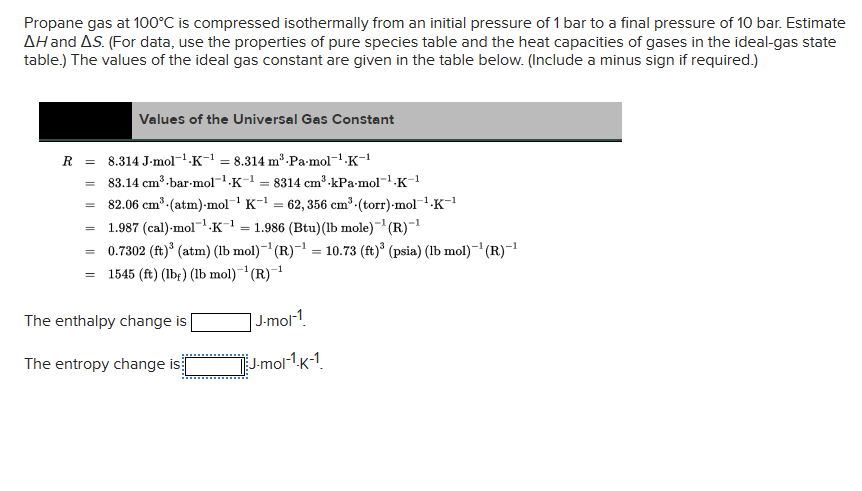Propane gas at 100°C is compressed isothermally from an initial pressure of 1 bar to a final pressure of 10 bar. Estimate AH and AS. (For data, use the properties of pure species table and the heat capacities of gases in the ideal-gas state table.) The values of the ideal gas constant are given in the table below. (Include a minus sign if required.)
Propane gas at 100°C is compressed isothermally from an initial pressure of 1 bar to a final pressure of 10 bar. Estimate AH and AS. (For data, use the properties of pure species table and the heat capacities of gases in the ideal-gas state table.) The values of the ideal gas constant are given in the table below. (Include a minus sign if required.)
Introduction to Chemical Engineering Thermodynamics
8th Edition
ISBN:9781259696527
Author:J.M. Smith Termodinamica en ingenieria quimica, Hendrick C Van Ness, Michael Abbott, Mark Swihart
Publisher:J.M. Smith Termodinamica en ingenieria quimica, Hendrick C Van Ness, Michael Abbott, Mark Swihart
Chapter1: Introduction
Section: Chapter Questions
Problem 1.1P
Related questions
Question

Transcribed Image Text:Propane gas at 100°C is compressed isothermally from an initial pressure of 1 bar to a final pressure of 10 bar. Estimate
AH and AS. (For data, use the properties of pure species table and the heat capacities of gases in the ideal-gas state
table.) The values of the ideal gas constant are given in the table below. (Include a minus sign if required.)
R =
=
=
=
Values of the Universal Gas Constant
82.06 cm³ (atm)-mol-¹ K-¹ = 62, 356 cm³-(torr)-mol-¹.K-¹
1.987 (cal)-mol¹K¹ = 1.986 (Btu) (lb mole)-¹(R)-¹
0.7302 (ft)³ (atm) (lb mol)-¹(R)-¹ = 10.73 (ft)³ (psia) (lb mol)-¹(R)-¹
-1
= 1545 (ft) (lb) (lb mol)-¹(R)-¹
=
8.314 J-mol-¹-K-¹ = 8.314 m³-Pa-mol-¹.K-¹
83.14 cm³-bar-mol-¹.K-¹8314 cm³-kPa-mol-¹-K-¹
The enthalpy change is
The entropy change is
1
J-mol-1
J-mol-¹-K-1
Expert Solution
This question has been solved!
Explore an expertly crafted, step-by-step solution for a thorough understanding of key concepts.
This is a popular solution!
Trending now
This is a popular solution!
Step by step
Solved in 2 steps

Recommended textbooks for you

Introduction to Chemical Engineering Thermodynami…
Chemical Engineering
ISBN:
9781259696527
Author:
J.M. Smith Termodinamica en ingenieria quimica, Hendrick C Van Ness, Michael Abbott, Mark Swihart
Publisher:
McGraw-Hill Education

Elementary Principles of Chemical Processes, Bind…
Chemical Engineering
ISBN:
9781118431221
Author:
Richard M. Felder, Ronald W. Rousseau, Lisa G. Bullard
Publisher:
WILEY

Elements of Chemical Reaction Engineering (5th Ed…
Chemical Engineering
ISBN:
9780133887518
Author:
H. Scott Fogler
Publisher:
Prentice Hall

Introduction to Chemical Engineering Thermodynami…
Chemical Engineering
ISBN:
9781259696527
Author:
J.M. Smith Termodinamica en ingenieria quimica, Hendrick C Van Ness, Michael Abbott, Mark Swihart
Publisher:
McGraw-Hill Education

Elementary Principles of Chemical Processes, Bind…
Chemical Engineering
ISBN:
9781118431221
Author:
Richard M. Felder, Ronald W. Rousseau, Lisa G. Bullard
Publisher:
WILEY

Elements of Chemical Reaction Engineering (5th Ed…
Chemical Engineering
ISBN:
9780133887518
Author:
H. Scott Fogler
Publisher:
Prentice Hall


Industrial Plastics: Theory and Applications
Chemical Engineering
ISBN:
9781285061238
Author:
Lokensgard, Erik
Publisher:
Delmar Cengage Learning

Unit Operations of Chemical Engineering
Chemical Engineering
ISBN:
9780072848236
Author:
Warren McCabe, Julian C. Smith, Peter Harriott
Publisher:
McGraw-Hill Companies, The